
BIDDINGTON'S ART GALLERY
ART APPRAISALS & VALUATIONS

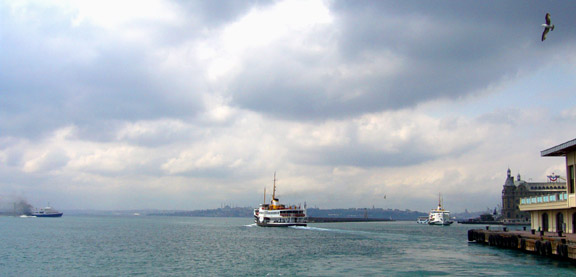
Touring Istanbul, Turkey
Editor's Note: Jake Biddington takes over for this Europe encounters Asia installment of The Bentley--published in June 2008.
 In my mind's eye and in my mind's ear, the plate tectonics of Istanbul abut with an audible grinding pressure. It is not only Eastern culture versus Western culture, but also ancient vs. modern vs. contemporary worlds that confront one another here.
In my mind's eye and in my mind's ear, the plate tectonics of Istanbul abut with an audible grinding pressure. It is not only Eastern culture versus Western culture, but also ancient vs. modern vs. contemporary worlds that confront one another here.
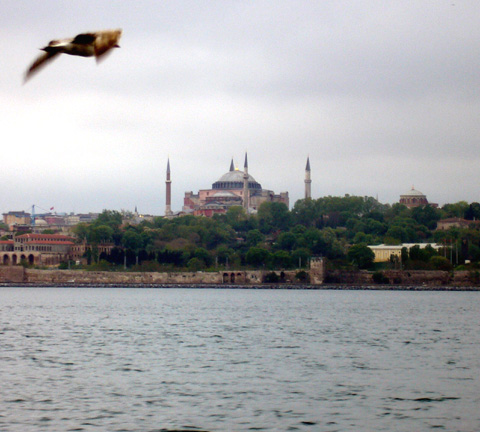
Hagia Sophia Viewed from the Bosphorus Straits
It's inescapable, the sense of Istanbul not only as intersection but as fault line. Whether ferrying across the Bosphorus Strait to Kadiköy (in Asia) dodging the endless queue of freighters or taking turns to shoot photos from the strategic promontory of Topkapi Palace (in Europe), all countries, all cultures seem to pause at this juncture.
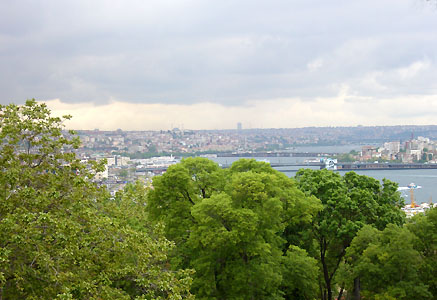
The uplifted plate in this geological metaphor is the glorious ancient world preserved within the confines of the historic Sultanahmet. Here Topkapi Palace reigns over the spot where the Sea of Marmara, The Golden Horn and the Bosphorus meet. This commanding vantage point enjoys an imperial view up the strait and across the surrounding hills on both the European and Asian sides. It feels as though the known world is at your feet.
The View from Topkapi Palace Up the Bosphorus Straits
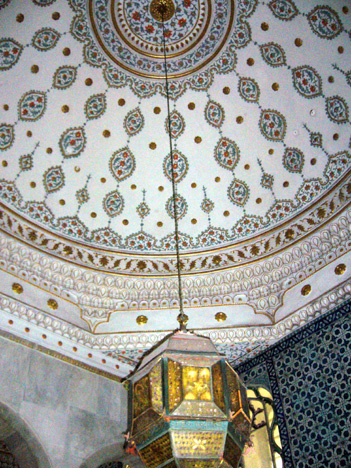
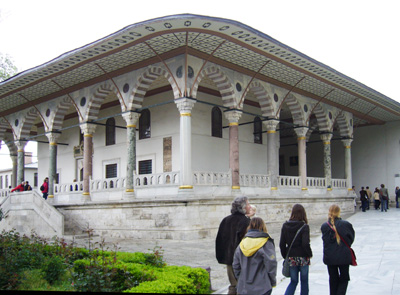 At Topkapi Palace, the Koranic prohibition against depicting (and therefore idolizing) the natural world in any literal form seems to have provided the architects, artists and artisans who made the palace with the boundaries they needed to transform mere decoration into magical rhythms of form, line and color.
At Topkapi Palace, the Koranic prohibition against depicting (and therefore idolizing) the natural world in any literal form seems to have provided the architects, artists and artisans who made the palace with the boundaries they needed to transform mere decoration into magical rhythms of form, line and color.
Interior Tile Work and Exterior Archway of the Library at Topkapi Palace
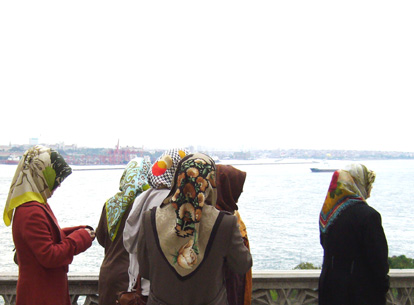
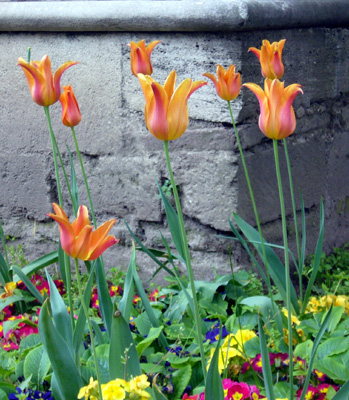 In this idyllic walled city, school children on much-awaited field trips frolic, jostle and try out their English on foreigners; groups of relaxed women in Hermes headscarves chat and instant message absent friends.
In this idyllic walled city, school children on much-awaited field trips frolic, jostle and try out their English on foreigners; groups of relaxed women in Hermes headscarves chat and instant message absent friends.
Turkish Tourists and Turkish Tulips
on the Topkapi Palace Grounds
Commerce in Contemporary Istanbul
Native son Orhan Pamuk's intimate memoir of mid-20th century Istanbul portrays a place of mystery and languid melancholy where the remembered glory of the Ottoman Empire squelches creativity and ambition. By contrast, Istanbul's 21st century reality is that of a striving and abrasive commercial metropolis. Contemporary Turkey is neither the land of financial engineering, nor of paper profits. As a consequence, Istambuli's treat commerce as a zero sum game: Getting ahead here consists of transferring your money into my pocket.
Apart from the historic sites, the city is a gritty, harsh workaday environment where the gap between rich and poor looms large. The visitor need only watch a poor sod dragging a handcart laden with textiles up a steep cobbled street to imagine an immutable world centuries old where subsistence is the primary goal.
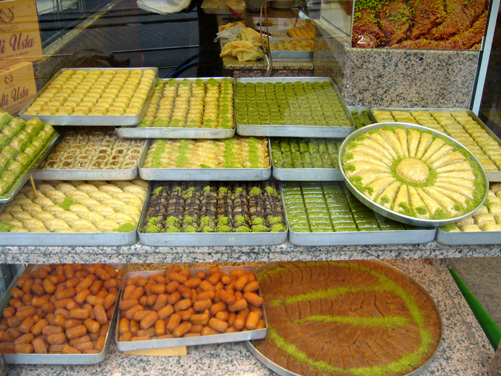
A Pastry Shop Window Early in the Day
Home to a huge garment industry, many international brands are made in Turkey. Even the Turks outsource to China some of the stitching. Shipping to China is quoted in cents per kilo: for example, 67 cents to China and back, to be finished in Istanbul. In the markets and along the sidewalk, major brands like Prada and Ralph Lauren are available for purchase having "fallen off the hand cart", so to speak. On the European Union admission point, it is easy to argue both sides of the Turkey inclusion/exclusion debate: the economic potential vs. the human deluge.
To enjoy this city, the visitor quickly learns to take its sights and sounds at face value. Istanbul's fairy tale architecture with minarets and domes punctuating the hillsides is unimaginably beautiful. When the Muslim call to prayer echoes (5 times daily) via loudspeakers, it is as though the imams at neighboring mosques were performing a version of dueling banjos. Since 1924 when Kemal Ataturk instituted reforms, the country has been a secular state, but over the past 20 years the culture has grown increasingly religious. While young women still speak of Ataturk with adoration, these days many Turkish women wear headscarves, and nearly all dress with extreme modesty. Other than in tourist and shopping zones such as the fashionable Pera, it is mostly men who populate the streets, especially after nightfall.
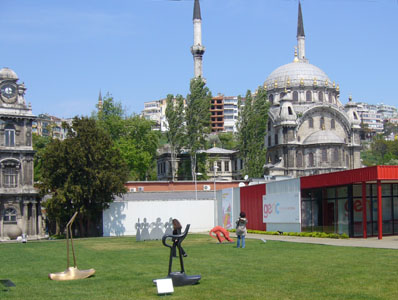
Contemporary Art and Artisans in Istanbul
Aesthetically, the ancient world still presses down upon Istanbul. While Turkish calligraphers of the 16th century city were intrigued (and quietly influenced) by figures in Venetian painting, the official culture only fully opened to Western European painting concepts when Ataturk rose to power.
Sculpture Garden at Istanbul Modern Museum
Istanbul Modern Museum's permanent collection chronicles the development of Western European style painting in Turkey. Not surprisingly, the results are more competent than inspiring. How could an aesthetic heritage based for centuries on intricate design suddenly turn itself whole-heartedly to modernism? Since the artist must (to some extent) ignore his cultural roots, the 20th century works by Turkish painters look warmed-over or derivative. When younger artists try to by-pass this absorbing/assimilation of foreign techniques, their works tend to lack structure. It takes time and rumination to meld cultural influences. This is a young process in Turkey. Art tends to work in geologic time.
Turkish Carpets
This leaves the best of the cultural expression in traditional hands, literally. It is the Anatolian carpet weavers who still produce a sublime product that expresses the richness of the country in concert with its refined visual heritage. Of course, as in the Andes or the American Southwest, weavers tend to earn a pittance, so those continuing the tradition are ever fewer. Near the Blue Mosque, the beautiful domed former bathhouse has been transformed into a display venue for traditionally made Turkish rugs. Both knotted rugs and kilims (flat weaves) are on view. These rugs are for sale at representative prices, but no salesman will trouble you at this state-sponsored site. Look and learn a bit here, then go shopping in the surrounding neighborhood (avoiding the Grand Bazaar where imports and inferior goods prevail). Allow a shop owner to pour you a tea and explain his wares sharing knowledge about the evolution of patterns and dyes. If he begins the discussion with price, move on until you find someone who loves what he is selling and wants you to enjoy it, too. Then choose your rug; you can spend $150 or you can spend $15,000, but from a professional Istanbul rug dealer you will still have found good value in all senses of the word
Particular Pleasures of Istanbul: Hookahs & Hamams
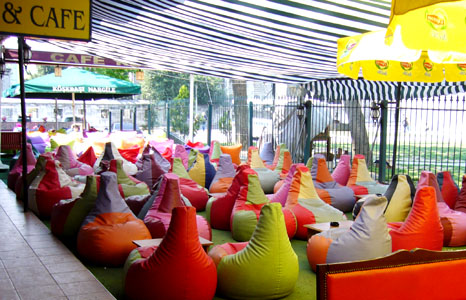 Waterpipes
Waterpipes
On the Beyoglu side (across the Galata Bridge from the historic city) the beer drinking Friday evening rabble makes Nevizade Sokak feel like 2nd Avenue in Manhattan. Alternatively, a sleek, non-drinking crowd heads down the hill to Kolhane. This set decadently lounges in beanbag chairs, drinks tea and breathes in the sweetly fragrant smoke from hookahs in the several nagileh bars that front the Bosphorus near the Istanbul Modern Art Museum.
Off-Hours at a Nagileh Cafe
Turkish Baths
On a chilly day, of which there are many in Istanbul, spending an hour or two at a Turkish bath both cleanses and coddles in a way unknown to most of us since infancy. This is not the standard spa experience. Both the Cemberlitas and the Sulemani hamams (bath houses) and still located in magnificent 16th century buildings designed by Sinan, the pre-eminent architect of the Ottoman Empire's golden age. Being sudsed, scrubbed and drenched in one of these glorious domed spaces is to take a sensual trip back in time.
Food Markets and Dining in Istanbul
Turkish cuisine is traditionally rich in fresh vegetables; add to that the abundance of fish from the surrounding waters and the result is a cuisine that is both delicious and healthy. Because of sin taxes, local Turkish wines (poor quality) and European imports tend to be scarce and overpriced. Beer or raki, a Turkish version of anisette flavored Pernod, are better options. The local non-alcoholic cherry drink is also an interesting choice.

Kumkapi Fish
For destination dining, have your hotel arrange a taxi to the Kumkapi seafood restaurants.
"Excuse me! Excuse me!" the Kumkapi restaurant hawkers shout insistently, then try to divine your country of origin with a follow up in English, French, German or Spanish. Walking through this dense and lively cluster of indoor/outdoors fish restaurants is much like navigating the Grand Bazaar where every vendor has a "deal". Fish prices vary greatly, and most is sold by weight; so, it is worth checking prices prior to being seated. A fish such as the abundant chupra will be modestly priced, while the rare turbot may sell for as much as $80 a portion.
The instant you are seated, a waiter comes buy with a platter of meze--appetizers such as roasted eggplant or mixed vegetables or a shellfish salad, whatever is fresh and readily available in the market. Just point to what you want. Then the usual ordering process occurs.
Kumkapi is near the Maimara fish market and a 20 minute walk down the hill from the Grand Bazaar through the garment district. At night, it is advisable to use taxi to and from this zone. Walking east toward the Sultanahmet is reasonably safe, but the rough neighborhoods just west of Kumkapi are best avoided after dark. Market Street in Kadikoy on the Asian Side of Istanbul
A Trip to the Asian Side of Istanbul
There are standard tourist excursions to stops up and down the Bosphorus, but for a similar experience avoiding the whole tourist nonsense, just catch a ferry for Kadiköy at the terminal next to the Eminönü tram stop. Ferries run every half hour, with minimal turn around time, and the trip takes about 45 minutes. At, Kadiköy follow the crowd from the dock up to the market streets and look at the sparklingly fresh fish and produce. When you can stand it no longer, find a table, indoors or out, at Ciya, a classic restaurant on Güneslibahce Sokak. The waiter will tell you what is available or, better yet, take you to the counter to show you the amazing possibilities. So much food, so little time.
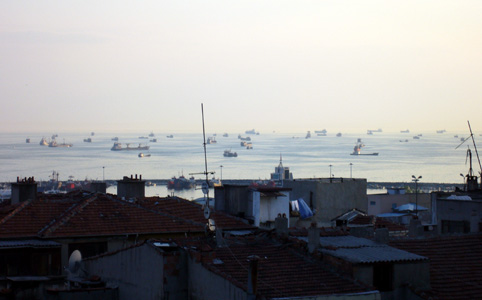
More Tourism Notes
Taxis
Istanbul taxi drivers are frequently "confused" about destinations, prices and change. So, is best to hire a taxi or car service through the hotel or at a restaurant rather than hailing a cab on the street.
Public Transportation
The tram, ferry and bus systems can all be accessed via an electronic "Akbil" pass that is purchased at kiosks near the major tram stops. This handy device saves the problem of needing loose change. While these transit services work frequently and reliably during the daytime, most shut down around midnight. So, a plan B is needed for returning to the hotel after a night out. Also, inexplicably, the Tünel funicular from Galata Tower up to Taksim Square closes around nightfall.
Museums
Istanbul Modern Museum of Art. Address: Meclisi Mebusan Cadddesi, Beyoglu side near the Kolhane tram stop.
Pera Museum. Permanent collection of Oriental portraiture paintings as well as temporary exhibits. Address: Mesrutiyet Caddesi 141, Beyoglu.
Hotels
Beyoglu Area
In Beyoglu, the Marmara Pera Hotel, a contemporary tower hotel, offers all the creature comforts as well as Mikla a trendy restaurant on site. The neighborhood is a good choice for business, for late nights or for general shopping. Address: Mesrutiyet Caddesi 167, Beyoglu.
Sultanahmet Area--For comfortable touring, good dining without transportation concerns and very good rug shopping, choose one of the several hotels in the Sultanamet zone: e.g. Four Seasons or the Turkish style boutique Kybele Hotel.
Grand Bazaar Area
For the tourist on a strict budget, Hotel Niles is a clean, inexpensive hotel with good service and a pretty roof terrace situated very close to the Grand Bazaar and a 10 minute walk from the Sultanahmet's historic sites. Address: Near Ordu Caddesi on Dibekeli Cami Sokak, 19, Beyazit.
Dining and Bars on the Historic City Side
Because alcohol cannot be served within 100 meters of a mosque, finding a spot in the historic district to have a glass of wine or a cocktail can be a challenge. Usually hotels offer some kind of bar service.
Kir Evi-Restaurant with weekend music. Address: Near Divanyolu Caddesi on Hoca Rustem Sokak, 9, Sultanahmet.
The Cure--Restaurant, bar and sometimes music. Address: Near Divanyolu Caddesi on Ticarethand Sokak, 35, Sultanahmet.
Adonin--Cafe, restaurant and bar. Address: Near Divanyolu Caddesi on Ticarethand Sokak, 27, Sultanahmet.
 South American Destinations:
South American Destinations:
Restaurant Guide to Buenos Aires--2008
Argentina: Jujuy Province, Humahuaca and Tilcara
Northwest Argentina: Tucumán, Salta & Cafayate
Santiago & Valparaiso, Chile
Tigre, Argentina--Day Trip from Buenos Aires
San Antonio de Areco, Argentina--Weekend Trip from Buenos Aires
Colonia, Uruguay--Overnight Trip near Buenos Aires
Buenos Aires--Basic Guide
Travel Guide to Montevideo, Uruguay
Other Archived Destinations:
Visiting New York City 2007
Visiting New York City 2006 (Archive)
New Haven, Connecticut
Amsterdam
Cultural Touring along Spain's Costa del Sol
Touring in Lisbon
Touring in Milan
Touring in Antwerp
Touring in Barcelona
I-80 Park City to New York City
Tourism New York City 2003 Update
Tourism New York City 2002
Hudson, New York (Columbia County)
Tourism Rome 2002 Update
Hartford & Wilton, Connecticut
San Francisco Jackson Square
New Hampshire Route 1A
Morris County, New Jersey
ABOUT THIS FEATURE
Here at BIDDINGTON'S, our work is also our play. When we're not exhibiting and discussing art online, we're learning about wonderful objects in shops, at great shows and in museums--or simply exploring the world's fascinating cultural diversity. In this article, Jake Biddington offers tourist information and descriptions of this interesting destination.
Contact Jake Biddington about His Travels
COPYRIGHT: Images and information within www.biddingtons.com are Copyright Biddington's, Inc.--except where preceded by individual copyrights of the artists.
Downloading or printing for online or print reproduction of any materials without specific written permission from Biddington's, Inc. is prohibited.
PEDIGREE & PROVENANCE CREATIVE PROCESS
JAKE BIDDINGTON'S INVESTING









 At Topkapi Palace, the Koranic prohibition against depicting (and therefore idolizing) the natural world in any literal form seems to have provided the architects, artists and artisans who made the palace with the boundaries they needed to transform mere decoration into magical rhythms of form, line and color.
At Topkapi Palace, the Koranic prohibition against depicting (and therefore idolizing) the natural world in any literal form seems to have provided the architects, artists and artisans who made the palace with the boundaries they needed to transform mere decoration into magical rhythms of form, line and color.
 In this idyllic walled city, school children on much-awaited field trips frolic, jostle and try out their English on foreigners; groups of relaxed women in Hermes headscarves chat and instant message absent friends.
In this idyllic walled city, school children on much-awaited field trips frolic, jostle and try out their English on foreigners; groups of relaxed women in Hermes headscarves chat and instant message absent friends.

 Waterpipes
Waterpipes


